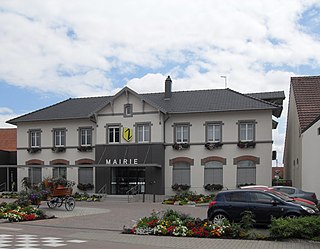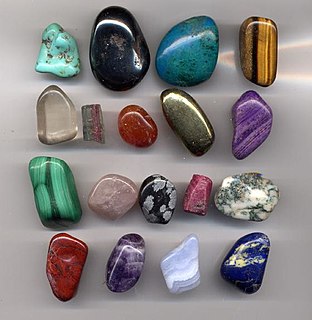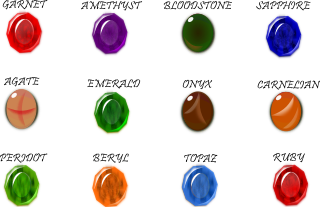This article does not cite any sources .(June 2018) (Learn how and when to remove this template message) |
| Georg Friedrich Strass | |
|---|---|
| Born | 29 May 1701 Wolfisheim bei Strasbourg |
| Died | 22 December 1773 (aged 72) |
| Nationality | Alsatian |
| Other names | Georges Frédéric Strass |
| Occupation | jeweler |
| Known for | Inventor of the rhinestone (aka strass) |
Georg Friedrich Strass (French : Georges Frédéric Strass; 29 May 1701, Wolfisheim near Strasbourg - 22 December 1773) was an Alsatian jeweler and inventor of imitation gemstones. He is best known as the inventor of the rhinestone, called strass in many European languages, from a particular type of crystal he found in the river Rhine.

French is a Romance language of the Indo-European family. It descended from the Vulgar Latin of the Roman Empire, as did all Romance languages. French evolved from Gallo-Romance, the spoken Latin in Gaul, and more specifically in Northern Gaul. Its closest relatives are the other langues d'oïl—languages historically spoken in northern France and in southern Belgium, which French (Francien) has largely supplanted. French was also influenced by native Celtic languages of Northern Roman Gaul like Gallia Belgica and by the (Germanic) Frankish language of the post-Roman Frankish invaders. Today, owing to France's past overseas expansion, there are numerous French-based creole languages, most notably Haitian Creole. A French-speaking person or nation may be referred to as Francophone in both English and French.

Wolfisheim is a commune in the Bas-Rhin department in Grand Est in north-eastern France.

Strasbourg is the capital and largest city of the Grand Est region of France and is the official seat of the European Parliament. Located at the border with Germany in the historic region of Alsace, it is the capital of the Bas-Rhin department. In 2016, the city proper had 279,284 inhabitants and both the Eurométropole de Strasbourg and the Arrondissement of Strasbourg had 491,409 inhabitants. Strasbourg's metropolitan area had a population of 785,839 in 2015, making it the ninth largest metro area in France and home to 13% of the Grand Est region's inhabitants. The transnational Eurodistrict Strasbourg-Ortenau had a population of 915,000 inhabitants in 2014.
He used mixtures of bismuth and thallium to improve the refractive quality of his imitations, and altered their colors with metal salts. The imitations were, in his view, so similar to real gems that he invented the concept of the "simulated gemstone" to describe them. He considerably improved his gems' brilliance by gluing metal foil behind them. This foil was later replaced with a vapor-deposited mirror coating.

Bismuth is a chemical element with symbol Bi and atomic number 83. It is a pentavalent post-transition metal and one of the pnictogens with chemical properties resembling its lighter homologs arsenic and antimony. Elemental bismuth may occur naturally, although its sulfide and oxide form important commercial ores. The free element is 86% as dense as lead. It is a brittle metal with a silvery white color when freshly produced, but surface oxidation can give it a pink tinge. Bismuth is the most naturally diamagnetic element, and has one of the lowest values of thermal conductivity among metals.

Thallium is a chemical element with symbol Tl and atomic number 81. It is a gray post-transition metal that is not found free in nature. When isolated, thallium resembles tin, but discolors when exposed to air. Chemists William Crookes and Claude-Auguste Lamy discovered thallium independently in 1861, in residues of sulfuric acid production. Both used the newly developed method of flame spectroscopy, in which thallium produces a notable green spectral line. Thallium, from Greek θαλλός, thallós, meaning "a green shoot or twig", was named by Crookes. It was isolated by both Lamy and Crookes in 1862; Lamy by electrolysis, and Crookes by precipitation and melting of the resultant powder. Crookes exhibited it as a powder precipitated by zinc at the International exhibition, which opened on 1 May that year.

A metal is a material that, when freshly prepared, polished, or fractured, shows a lustrous appearance, and conducts electricity and heat relatively well. Metals are typically malleable or ductile. A metal may be a chemical element such as iron, or an alloy such as stainless steel.
Strass opened his own business in 1730, and devoted himself wholly to the development of imitation diamonds. Due to his great achievements, he was awarded the title "King's Jeweler" in 1734.

A diamond simulant, diamond imitation or imitation diamond is an object or material with gemological characteristics similar to those of a diamond. Simulants are distinct from synthetic diamonds, which are actual diamonds having the same material properties as natural diamonds. Enhanced diamonds are also excluded from this definition. A diamond simulant may be artificial, natural, or in some cases a combination thereof. While their material properties depart markedly from those of diamond, simulants have certain desired characteristics—such as dispersion and hardness—which lend themselves to imitation. Trained gemologists with appropriate equipment are able to distinguish natural and synthetic diamonds from all diamond simulants, primarily by visual inspection.
He was a partner in the jewellery business of Madame Prévot. He continued improving his artificial gemstones during this time. His work was in great demand at the court of King Louis XV of France, and he controlled a large market for artificial gems.

Louis XV, known as Louis the Beloved, was a monarch of the House of Bourbon who ruled as King of France from 1 September 1715 until his death in 1774. He succeeded his great-grandfather Louis XIV at the age of five. Until he reached maturity on 15 February 1723, the kingdom was ruled by Philippe II, Duke of Orléans, as Regent of France. Cardinal Fleury was his chief minister from 1726 until the Cardinal's death in 1743, at which time the young king took sole control of the kingdom.
Wealthy through his businesses, he was able to retire comfortably at age 52.
| This glass art related article is a stub. You can help Wikipedia by expanding it. |
| This French biographical article is a stub. You can help Wikipedia by expanding it. |













